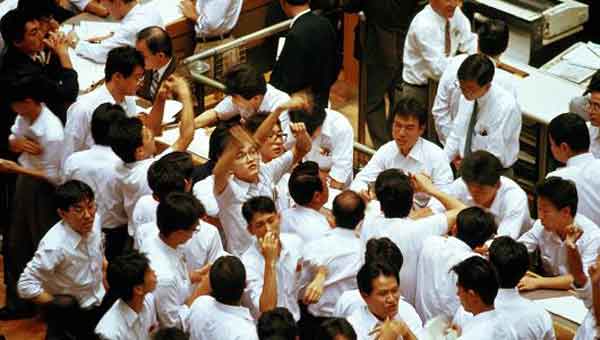Beijing, China (BBN)- Asian equities were a mixed picture, as traders digest China’s February inflation data and track crude oil prices.
China’s producer price index (PPI) jumped more than expected by 7.8 per cent in February from the previous year, the fastest pace since September 2008, reports CNBC.
In contrast, consumer prices slowed, to 0.8 per cent year-on-year, its slowest pace since January 2015.
The Shanghai composite was down 0.7 per cent and the Shenzhen composite fell 0.59 per cent.
Hong Kong’s Hang Seng plunged 0.96 per cent.
Japan’s Nikkei 225 was up 0.1 per cent, slipping from earlier increases.
The benchmark ASX 200 wavered for most of the morning session, last trading down 0.36 per cent.
The index was weighed heavily by a 1.87 per cent drop in its energy sub-index and a 2.34 per cent decline in its materials sub-index.
Crude benchmarks plunged more than 5 percent during US hours on Wednesday after US crude inventories surged to a record high at an increase of 8.2 million barrels last week, compared with the consensus expectation for a 2 million barrels.
But oil recovered during Asian hours, as US West Texas Intermediate crude steadied to climb 0.66 per cent to $50.62 a barrel, while global benchmark Brent crude rose 0.79 per cent to $53.55.
South Korea’s Kospi was nearly flat, up 0.04 per cent.
Samsung Electronics was down 0.05 per cent, Samsung C&T was flat and Samsung Heavy shed 2.06 per cent.
Meanwhile, Samsung Group’s chief Jay Y. Lee will go on trial for bribery and embezzlement, amid a corruption scandal that has led to the impeachment of President Park Geun-hye.
Traders in the region will also watch for more geopolitical-related news out of east Asia, after Washington’s ambassador to the United Nations Nikki Haley said Wednesday that the UN was re-evaluating how it must deal with North Korea after it’s repeated missile tests and that “all options are on the table.”
Over in the US, major indexes closed mostly lower amid plunging oil prices and data which showed private sector employment added 298,000 jobs last month, according to ADP and Moody’s, well above a Reuters poll estimate of 190,000.
“Bumper US ADP payrolls re-energizes the dollar and sends UST 10-year yields ever-closer to the key 2.60 per cent level,” said Nizam Idris, Gareth Berry, and Teresa Lam, strategists at Macquarie Bank in a Thursday note.
“If Friday’s nonfarm payrolls convey a similar message about labour market strength, Fed may signal 4 hikes for 2017 in their new dot plot.”
The Dow Jones industrial average was down 0.33 per cent, or 69.03 points at 20,855.73, the S&P 500 dropped 0.23 per cent or 5.41 points to close at 2,362.98 and the Nasdaq composite rose just 0.06 per cent or 3.62 points to end at 5,837.55.
On Wednesday, China unexpected posted its first trade deficit in three years last month, as a construction boom pushed imports up 38.1 per cent in dollar-denominated terms as exports fell 1.3 per cent.
The upbeat data reinforced that China’s economic activity picked up in the first two months in 2017 and contributed to a global manufacturing revival, Reuters reported.
The dollar index was trading at 102.10 during Asian time, above the levels around 101 for the past four sessions.
The stronger dollar led the yen to weaken to 114.38 by 10:10 am HK/SIN and the Australian dollar slipped to $0.7523.
BBN/SK/AD

No Subscription? You Are Missing Out!
Join the business leaders of Bangladesh who rely on BBN's original reporting and in-depth analysis on business scenario of the country. We send only one daily email. No Spam Guaranteed!









